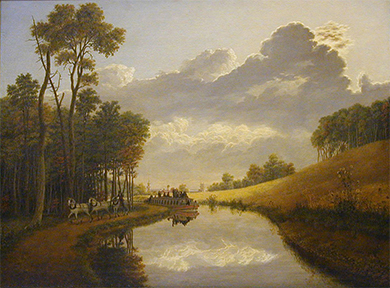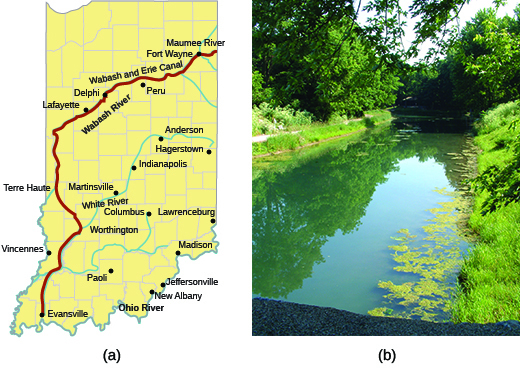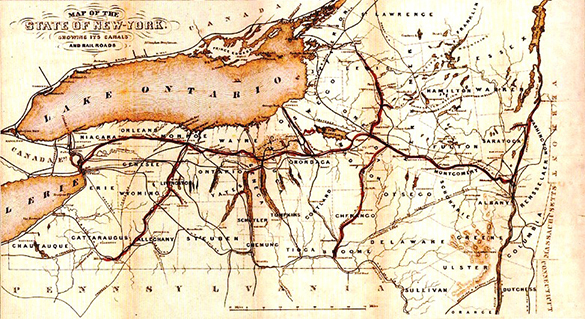| << Chapter < Page | Chapter >> Page > |

Explore the Erie Canal on ErieCanal.org via an interactive map. Click throughout the map for images of and artifacts from this historic waterway.
The success of the Erie Canal led to other, similar projects. The Wabash and Erie Canal, which opened in the early 1840s, stretched over 450 miles, making it the longest canal in North America ( [link] ). Canals added immensely to the country’s sense of progress. Indeed, they appeared to be the logical next step in the process of transforming wilderness into civilization.

Visit Southern Indiana Trails to see historic photographs of the Wabash and Erie Canal:
As with highway projects such as the Cumberland Road, many canals were federally sponsored, especially during the presidency of John Quincy Adams in the late 1820s. Adams, along with Secretary of State Henry Clay, championed what was known as the American System, part of which included plans for a broad range of internal transportation improvements. Adams endorsed the creation of roads and canals to facilitate commerce and develop markets for agriculture as well as to advance settlement in the West.
Starting in the late 1820s, steam locomotives began to compete with horse-drawn locomotives. The railroads with steam locomotives offered a new mode of transportation that fascinated citizens, buoying their optimistic view of the possibilities of technological progress. The Mohawk and Hudson Railroad was the first to begin service with a steam locomotive. Its inaugural train ran in 1831 on a track outside Albany and covered twelve miles in twenty-five minutes. Soon it was traveling regularly between Albany and Schenectady.
Toward the middle of the century, railroad construction kicked into high gear, and eager investors quickly formed a number of railroad companies. As a railroad grid began to take shape, it stimulated a greater demand for coal, iron, and steel. Soon, both railroads and canals crisscrossed the states ( [link] ), providing a transportation infrastructure that fueled the growth of American commerce. Indeed, the transportation revolution led to development in the coal, iron, and steel industries, providing many Americans with new job opportunities.

The expansion of roads, canals, and railroads changed people’s lives. In 1786, it had taken a minimum of four days to travel from Boston, Massachusetts, to Providence, Rhode Island. By 1840, the trip took half a day on a train. In the twenty-first century, this may seem intolerably slow, but people at the time were amazed by the railroad’s speed. Its average of twenty miles per hour was twice as fast as other available modes of transportation.
By 1840, more than three thousand miles of canals had been dug in the United States, and thirty thousand miles of railroad track had been laid by the beginning of the Civil War. Together with the hundreds of steamboats that plied American rivers, these advances in transportation made it easier and less expensive to ship agricultural products from the West to feed people in eastern cities, and to send manufactured goods from the East to people in the West. Without this ability to transport goods, the market revolution would not have been possible. Rural families also became less isolated as a result of the transportation revolution. Traveling circuses, menageries, peddlers, and itinerant painters could now more easily make their way into rural districts, and people in search of work found cities and mill towns within their reach.
A transportation infrastructure rapidly took shape in the 1800s as American investors and the government began building roads, turnpikes, canals, and railroads. The time required to travel shrank vastly, and people marveled at their ability to conquer great distances, enhancing their sense of the steady advance of progress. The transportation revolution also made it possible to ship agricultural and manufactured goods throughout the country and enabled rural people to travel to towns and cities for employment opportunities.

Notification Switch
Would you like to follow the 'U.s. history' conversation and receive update notifications?